Flagship Falcon
The Falcon 7X leads the bizjet pack in technology, safety, and style

To many, Dassault Aviation’s Falcon Jet line of business jets represents a pinnacle in the merging of technology and art. “Form follows function,” is the saying. If it’s true, this certainly explains why Falcons have reputations for both flying well and looking good. The most recent Falcon—the 7X—is no exception. The $52 million 7X is the flagship of the fleet and, as you might expect, it features a sumptuous cabin capable of flying 6,000 nm in high style.
But for pilots the focus of attention is more apt to be on the airplane’s fly-by-wire technology. The 7X went into service in 2007, and until recently it was the first and only business jet with full fly-by-wire flight controls (Gulfstream’s new G650 also uses fly-by-wire). With fly-by-wire, there are no cables, pulleys, pushrods, or other mechanical linkages connecting the cockpit controls with the flight surfaces. Instead, the controls manipulated by the pilots send digital electronic commands to actuators controlled by computers. Artificial feel gives pilots the accustomed tactile feedback, but make no mistake: this is an airplane run by electrons.
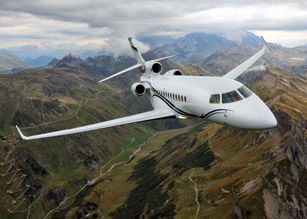
Dassault is a pioneer in digital design. It developed the CATIA (computer-aided three-dimensional interactive application) software the company uses in the design, definition, manufacture, and testing of the 7X and other Falcons. CATIA’s virtual processes ensure precise fit and conformity among aircraft. There are no mockups or prototype Falcons.
“Are you looking for paper blueprints stored in each design department?” Dassault official Jerome Camps asked at the company’s Virtual Reality Center in St. Cloud, France. “Don’t, because there aren’t any. All of the three-dimensional component data is shared among every element of the design and manufacturing teams—from the beginning to the end of the product life cycle.” CATIA is now the standard computer-aided design and manufacturing (CAD/CAM) tool used in the automotive and other industrial communities—including competing business jet manufacturers.
Dassault chose fly-by-wire for its potential to improve safety and simplify handling. One goal is to prevent the airplane from exceeding the margins of the flight envelope while achieving maximum performance. Another is to allow pilots to carry out instinctive reactions with optimum performance in emergency situations such as wind shear or collision avoidance. Enhancing stability and reducing pilot workload are other major targets.
Fly-by-wire has its detractors, but the 7X has built-in redundancy. The airplane has three main flight control computers (MFCC) and three secondary flight control computers (SFCC). These computers all work together to calculate control surface commands and keep the airplane in trim. However, even if five of those six computers somehow failed, a single computer can control the airplane.
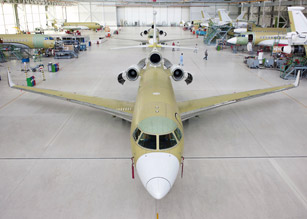
If something can go wrong it will, so the 7X’s flight control system can operate under four different control laws in case of sensor, actuator, computer, or data transmission failures. Think of these laws as layers of control.
Under normal law, all of the system controls and protections are functional. Next come alternate control laws, which automatically kick in should a malfunction occur. Now some of the system controls and functions may be shared among the computers. As a precautionary measure, all envelope and other protections are to be considered lost, even though some of them may be active.
If multiple failures occur, the 7X runs under direct laws. Although the pilot won’t have overspeed or underspeed protection, and no automatic trim, the airplane will still fly and land quite well. For the pilot, it would be like flying a conventional airplane.
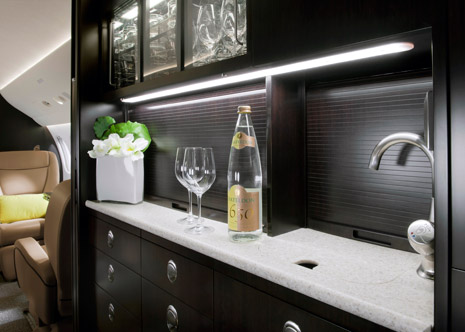
If the flight control system loses all MFCC and SFCC, the 7X reverts to backup mode. This leaves the pilot with manual trim controls for pitch control; rudder pedal sensors control the spoilers. This would be an extremely rare situation. Dassault says that odds are about one in a billion that you’ll ever get there, and emphasizes that its redundancies are more complete than any of its competitors.
There was an incident in May 2011 when a 7X experienced a pitch-trim runaway as it passed through 12,000 feet during a descent. The airplane reportedly climbed to 22,000 feet before the crew regained control and made an uneventful landing. An emergency airworthiness directive came out, and Dassault voluntarily grounded the 7X fleet until it was determined that a faulty horizontal stabilizer electronic control unit was to blame. The grounding was rescinded after new units, modifications, and procedures were put in place, and the airplane was back in service within 30 days.
My experience flying the 7x involved a generous 2.5 hours in CAE’s Level D simulator located in Morristown, New Jersey, and 1.8 hours flying a 7X demonstrator operated by Dassault Falcon Jet out of its North American headquarters at the Teterboro, New Jersey, airport. For each session my instructor was veteran Falcon demonstration pilot Don Tilley.
The 7X’s EASy (enhanced avionics system) avionics suite is based on Honeywell’s Primus Epic platform and features a four-screen setup, three flight management systems, three inertial reference systems, TCAS II, EGPWS, and much more. Soon, an upgraded suite—dubbed EASy II—will include synthetic vision plus WAAS GPS localizer performance with vertical guidance (LPV) capability, required navigation performance (RNP) authorization to 0.3 nm lateral tolerances, Controller Pilot Datalink Communciation (CPDLC), XM WX datalink weather, and Honeywell’s Runway Awareness and Advsory System (RAAS).
After all the prestart checks, it’s time to turn on the auxiliary power unit, power up the panel, and begin entering takeoff data using the EASy’s graphical flight planning feature. For each phase of flight there’s a symbolic airplane, and clicking on them opens up the menus. For takeoff, you use the pedestal-mounted trackball to scoot around the data fields, and a keypad to enter temperature, wind, altimeter setting, weight, and other items. Then the appropriate V-speeds pop up on the PFD airspeed tapes. It takes a while to get accustomed to navigating the EASy, which in essence is the same Epic system used in the Pilatus PC–12NG (Pilatus calls it Apex) and Gulfstream business jets (Gulfstream calls it PlaneView).
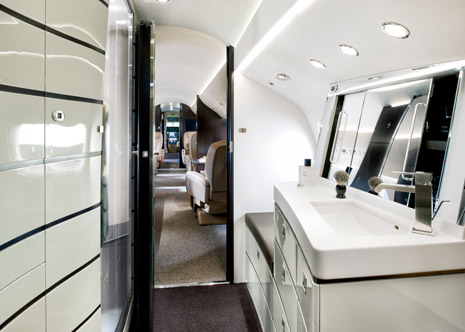
As Tilley and I taxied the ship (there’s no tiller, so taxi steering is via steer-by-wire through the rudder pedals) to Teterboro’s Runway 1, the slats and flaps were put to the second notch—SF2—for takeoff and our clearance came soon after. Up came the three thrust levers, and after a brief pause I let off on the brakes and Tilley and I, and our five passengers, went storming off toward our V1 of 120 KIAS.
Dassault Falcon believes pilots should be hands-on and without autopilot until reaching 400 feet agl, but once there the autothrottles and autopilot were engaged. I dialed in a 250-knot climb and saw 5,500 fpm as the initial climb rate. Our takeoff weight was 51,700 pounds (of which 14,640 pounds was in fuel)—18,300 pounds shy of max takeoff weight.
So what’s like to fly a 7X? Different—but in a good way—as I learned in the simulator. With conventional airplanes, you’re always trimming for a certain speed, fighting turbulence with various control inputs, and constantly adjusting heading and pitch to track a desired course. With the 7X, fly-by-wire digitally-controlled inputs relieve the pilot of this job—and flight director commands are based on path.
“Other airplanes trim to speed,” says Dassault Falcon’s director of avionics programs and pilot training, Woody Saland, Ph.D. “The 7X flies to path. If the digital controls could talk, they’d say, tell me what trajectory you want, then let go of the stick and let me go after what you’ve shown me.” This makes hand-flying a set-and-forget proposition. Simply pick a heading and attitude, use the sidestick to put the flight director where you want it, and release the stick. The airplane follows the command. During approaches and other tracking procedures, it’s the same thing. In all cases, path, not attitude, is primary. Saland says, “We don’t care where the nose of the airplane is pointing, we care about where the airplane is going.”
Pilots of conventional airplanes are conditioned to jink around, so it takes a while to forget all that and become accustomed to the 7X’s fly-by-wire control method. In the simulator I felt the need to constantly adjust the controls—something Tilley said that all neophytes do. It takes time to settle down and let the airplane do the flying.
Once the airplane is established on a path it’s rock steady, and constantly working to keep things that way. Add a gob of power to make a huge airspeed change? The airplane retrims while staying on path. Encounter some chop? Same deal. If you could somehow look at the airplane from the outside, you’d see the flight controls moving to stay on path, but inside the airplane the pilot need only watch the PFD to see that the airplane remains on path.
Thrust director symbology is also on the PFD. A green chevron rides up or down within a magenta bracket. If the chevron moves up, that’s a cue that power must be reduced in order to maintain the desired path at the desired airspeed. If it moves down, add power.
From Teterboro, we step-climbed to FL400, flew north to Albany at 490 KTAS burning 800 pph (119 gph) per engine, then descended, bound for the ILS approach to Runway 27 at Newburgh, New York’s Stewart International Airport. At 15,000 feet we leveled for some airwork. Now it was time to explore the 7X’s envelope protection.
First, a landing configuration stall. Or stall attempt, I should say. As the airplane slowed, an “increase speed” callout sounded and then, with full aft stick, the wing leading edge slats automatically deployed in order to automatically add a safety margin against a stall. With the autothrottles engaged, the engines would automatically spool up; if not, the flight control system will automatically lower the nose to prevent a stall. You may be pulling like mad on the sidestick, but this has no effect at all. In fact, the pilot is cut out of the control loop at this critical time. One big advantage: in wind shear encounters, pilots can simply haul back on the sidestick, knowing that the airplane will attain maximum angle of attack without stalling.
Similar protections exist for overspeeds. Fly to redline/barber pole and a “reduce airspeed” callout sounds, power will be reduced, and the nose will rise as the flight control system trims away the excess airspeed. There are similar protections against inadvertent excessive bank and pitch angles. For example, banks are limited to 35 degrees and pitch angles are limited to -18 and +25 degrees when flying at or below 100 KIAS.
The flight control system handled the ILS flight path to Stewart with style, but just for kicks I hand-flew the first part of the approach. Sure enough, I reverted to chasing the flight path marker. As always, it’s best to just set the marker in the flight director’s bull’s eye, release the stick, and watch as the 7X unerringly flies down final.
The approach back into Teterboro was a bit more challenging, what with a much shorter runway and weather at 800 and six in rain. The EASy flew the arrival and instrument procedures with precision, but on short final it was all up to me.
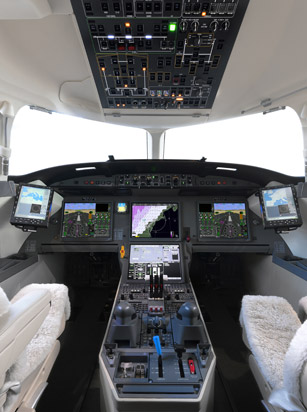
I’d practiced landings in CAE’s simulator, and it held me in good stead. The 113-knot VREF for our landing weight of 46,400 pounds that day was slow enough for a good flare—actually, Tilley offered that I flared a bit too much. That seemed easy to do, because the sight picture down the steeply-raked nose gave a great view of the runway ahead. Although the flare seemed OK, I should have landed at a flatter deck angle. As it happened, derotation took a bit longer—and the nosewheel touchdown was a tad firmer—than optimal. The 7X’s long wing and 34.5-degree sweep provide a lot of lift and are key to the airplane’s speed and fuel efficiency at altitude, but for landing it’s best to plant it firmly for the shortest landing distances. For the landing on Teterboro’s 7,000-foot-long Runway 19 there was a five-knot tailwind component. A landing that should have consumed about 3,000 feet instead consumed almost 5,000 feet, thanks to my eagerness to grease it. Reverse thrust (available on the center engine only) certainly helped, as did the automatic spoiler deployment as weight was transferred to the trailing-link landing gear, and the powerful brake-by-wire system with anti-skid.
The 7x is powered by three Pratt & Whitney PW307A engines of 6,402 lbst each. The idea of a trijet may seem over the top to some, but Dassault is a big believer, and its Falcon 900- and 50-series business jets also have three engines. The company cites safety benefits, such as improved engine-out takeoff climb gradients, which permit takeoffs from shorter runways. There’s also the reassurance when flying extended over water missions: Should an engine fail, the flight can be continued without sacrificing valuable speed and altitude. The center engine’s thrust carries an aerodynamic boost as well because it reduces drag by fooling the airplane into thinking it’s longer than it really is.
You hear criticism that running three engines is a waste of fuel. But Dassault Falcon says the 7X burns 20 to 30 percent less fuel than competing airplanes in its class, thanks to its lighter weight; larger, computer-designed wings; and lower drag. Carbon dioxide and other emissions are kept low by specially designed combustors in the PW307As. Throw in the extremely long odds of a turbofan conking out, and you can understand the company’s rationale behind opting for three engines.
No doubt about it, the 7X is as sophisticated as it is capable. Sure, it takes 25 days of schooling for its two pilots to earn the type rating, and some pilots even take advantage of Dassault Falcon’s “jump seat support pilot” program, in which company pilots ride along until new 7X crews get some seasoning. That process usually takes about 100 hours. But it’s worth it. For pilots and passengers alike, flying the 7X is every bit the experience you’d expect from an airplane at the top of its class.
Email [email protected]
SPEC SHEET
Falcon 7X
Average equipped price $52 million
Powerplants | (3) Pratt & Whitney Canada PW307A, 6,402 lbst ea
Length | 76 ft 1 in
Height | 25 ft 8 in
Wingspan | 86 ft
Wing area | 761 sq ft
Wing loading | 92 lb/sq ft
Seats | 2+12-16
Cabin length | 39 ft 1 in
Cabin width | 7 ft 7 in
Cabin height | 6 ft 2 in
Basic operating weight | 34,272 lb
Max ramp weight | 70,200 lb
Max takeoff weight | 70,000 lb
Zero fuel weight | 41,000 lb
Payload w/full fuel | 1,660 lb
Max landing weight | 62,400 lb
Fuel capacity, std | 4,767 gal (31,940 lb)
Performance
Takeoff distance | 5,710 ft
Time to climb to FL370 | 18 min
Engine-out ROC, sea level | 615 fpm
Range at Mach 0.80/ 3 crew, 8 pax, full fuel | 5,950 nm
Max operating altitude | 51,000 ft
Sea-level cabin | 29,200 ft
Landing distance | 2,262 ft
Limiting and Recommended Airspeeds
V2 (takeoff safety speed) | 133 KIAS
VREF (reference speed, final approach) | 104 KIAS
VMO (max operating speed) | 370 KIAS
MMO (max Mach number) | 0.90 M
For more information, contact Dassault Falcon Jet Corporation, 200 Riser Road, Little Ferry, New Jersey 07643; 201-541-4584; www.dassaultfalcon.com
All specifications are based on manufacturer’s calculations. All performance figures are based on standard day, standard atmosphere, sea level, max weight conditions unless otherwise noted.
Extra
The 7X’s flaps and slats work in tandem, but the flaps will only extend after the slats are fully deployed.



